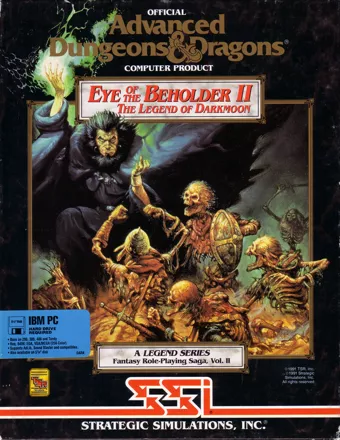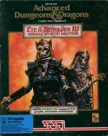Eye of the Beholder II: The Legend of Darkmoon
Description official descriptions
The Archmage Khelben summons the Heroes of Waterdeep, slayers of the Beholder Xanathar, for another mission. Strange things are happening in the forests near Waterdeep, centered around the Temple Darkmoon. People have been disappearing and shallow graves containing human remains have been found. Khelben teleports the party to the forests near Darkmoon so they may find out what kind of evil is working in the towers of the temple.
Eye of the Beholder II: The Legend of Darkmoon is, like its predecessor, a first-person dungeon-crawling role-playing game based on the second edition of AD&D rules. It uses the same point-and-click gameplay mechanics and controls as the first game, with only minor changes. The game is set entirely in pseudo-3D maze-like areas; no automapping is available. Combat flows in real time, and characters can move as a single unit to lure enemies or avoid blows.
A starting party consists of four characters, which can be transferred from the earlier game or created from scratch. Six classes (Fighter, Ranger, Paladin, Cleric, Mage, and Thief) are available. Characters can reach higher levels and learn new spells, must face new and tough monsters, and solve multiple puzzles. Compared to the first game, many more illustrated NPC encounters and cutscenes were added.
Spellings
- アイ・オブ・ザ・ビホルダーII - Japanese spelling
Groups +
- Dungeons & Dragons (D&D / AD&D) licensees
- Dungeons & Dragons Campaign Setting: Forgotten Realms
- Eye of the Beholder series
- Fantasy creatures: Dragons
- Fantasy creatures: Dwarves
- Fantasy creatures: Elves
- Fantasy creatures: Gnomes
- Fantasy creatures: Halflings / Hobbits
- Gameplay feature: Character development - Automatic leveling
- Gameplay feature: Hunger / Thirst
- Gameplay feature: Importable characters
- Games with manual lookup copy protection
- Genre: Dungeon Crawler
Screenshots
Promos
Credits (DOS version)
60 People (53 developers, 7 thanks) · View all
| Producer | |
| Playtesting | |
| Level & Manual Translation | |
| Set in German Manual |
|
| Special Thanks To | |
| Design | |
| Lead Programming | |
| Music | |
| Original Concept | |
| Sound | |
| Intro & Finale by | |
| Art & Graphics | |
| Writer | |
| Special Thanks |
|
| [ full credits ] | |
Reviews
Critics
Average score: 86% (based on 26 ratings)
Players
Average score: 4.0 out of 5 (based on 86 ratings with 4 reviews)
Extremely challenging, and extremely good.
The Good
Eye of the Beholder II is one of the classic CRPGs that set the standards for years to come. I have been trying to complete this game for over ten years now - ever since I first played it, and without success... until today. This goes to prove two things: the first is that EOB2 is an incredibly good game, and the second is that EOB2 is an incredibly tough game to beat.
So what's so good about it? The first thing that comes to mind is the brilliant graphics. Between the great 2D drawings that are so very typical of Westwood (as is clearly evident in The Legend of Kyrandia, for instance) and the very detailed psuedo-3D engine, the game really looks gorgeous; not having real freedom of movement - remember this game came out a full year before what I believe is the first realtime raycasted shooter, Catacomb Abyss - means that the artists had much more freedom than usual creating very detailed textures and sprites.
The interface is great - it is easy to learn and easy to manage. It is not perfect - some things could have been done better, for example the ability to see the compass and cast a spell at the same time, or being able to see character statistics at the same time as changing items (so one can see the immediate influence of the items), but despite these shortcomings the interface is extremely well designed and makes even intense battles easy to manage.
The music in the PC version is not as good as the Amiga version (despite having more sound channels) for obvious reasons, but it is still terrific, having being made by Frank Klepacki (later to make the music for both Dune 2 and Kyrandia).
The story is not particularly deep, but is very characteristic of the D&D or AD&D adventures that were commonly sold when these gaming systems were prevalent.
Finally, gameplay is extremely long (even someone deeply familiar with the game will probably need a few days to finish it), the environments are varied and the game is very satisfying over all.
The Bad
Like I said before, Eye of the Beholder II is incredibly difficult - occasionally ridiculously so. Some battles require dozens of reloads, and on occasion I just couldn't figure out a puzzle and had to use a walkthrough (I wish I could say this happened only once...). Kudos to anyone who's managed to finish the game without any outside help.
The Bottom Line
An incredible game, worthy of the title "An Advanced Dungeons & Dragons 2nd edition computer product".
DOS · by Tomer Gabel (4539) · 2002
One of the best old-time RPGs, perfect at all places
The Good
Following the same style as it's prequel with it's great graphics and atmosphere, it just gets even better by applying a consistent and interesting story that is revealed to the player throughout the game with greatly designed screens accompanied by the story or actions to be taken.
The places to visit are also more interesting, all taking place in an evil temple with it's deadly underground levels or suspicious priest chambers. Interesting riddles, fights that need special strategies, places that you can't rest, an NPC that steal your goods if you rest, a secret chamber to raise your dead and a lot of other neat surprises await you. It's simply more rich in story, fights, riddles and good ideas than any other title of the series. And it's definitely the biggest and most challenging of all.
The Bad
I can't find anything that I personally don't like. Maybe only the fact that sometimes you get lost (especially in levels with illusion or shifting walls) and there is no automap. But you tend to learn these places each time you play the game. The same happens with it's extreme difficulty. I have finished the game so many times that I have learned some very good strategies that levels like the skeleton chambers or the gargoyle dungeon (where you can't rest) do seem quite easy to me these days. The same happens with the later dungeons. And yet they still have exactly the right difficulty to become challenging in the good way. This only applies if you move with the arrows and have learned to apply side-stepping fighting a lot. One can really build up experience on winning in the Beholder series this way.
The Bottom Line
Definitelly the best dungeon crawling RPG game of all times. It's perfect, in terms of graphics, atmosphere, sounds and the right amount of challenge. Kinda hard for the beginner (and for this reason I would suggest you to try the prequel first before playing this) but it feels so great playing this again and again to get better and discover more strategies. EOB2 is really the best of the series.
DOS · by Optimus (75) · 2009
Look me in the eye while I turn you into stone
The Good
I haven't played this game's predecessor, so I can't compare between the two. This one was recommended to me as the best of the series, so I decided to skip the other two - especially since it took me quite a while to finish this very unforgiving game, even with the occasional (alright, frequent!) help of a cluebook.
I surely can't say that this was the most intense role-playing experience I've ever had; but I'm certain that every fan of the genre should give it a spin. Eye of the Beholder II is unlike other old dungeon crawlers not because it does something new, but because it does everything better. Repetitive randomness is something I personally can't stand in that type of games, and I was glad to discover that Eye of the Beholder II was anything but random. Every area in the game is hand-made, in the sense that it was designed rather than procedurally generated.
In essence, Eye of the Beholder II is almost like a hybrid between role-playing and adventure. There are so many puzzles and they are so prominent, that at times the entire game begins to feel like one gigantic puzzle. There are monsters to beat, sure, but battles against them are not the meat and potatoes of the game; it's the exploration itself, the careful mapping of the complex, intricately designed dungeons, the tackling of the tricky puzzles, which makes the game so addictive and exciting.
Dealing with pressure plates that need to be weighted in a specific fashion; frantically running through narrow corridors while avoiding deadly fireball traps; poking at every wall to discover an illusion wall that leads to the coveted key; trying to figure out how to navigate a series of confusing teleporters; breaking your head over that one item that is needed to pass a mystical barrier - these are the things you'll be busy doing, while the enemies in the game almost become a diversion, a way to release the stress.
That is not to say that those enemies can't kill you - quite on the contrary. The seemingly endless hordes of skeletal warriors in the very first dungeon; the first appearance of the powerful titular monster; the frustration of being petrified by a pesky basilisk when you are so near the goal - all those challenges exist as well; and, for the final battle, you'll need to master the sidestep technique to have any chance (it's actually much easier than it seems). That said, the battles in this game certainly don't rank among the hardest; and the ability to rest anywhere, anytime after battle (with a few exceptions) greatly facilitates things.
What really works well in Eye of the Beholder II is the element of novelty within the frames of a solid, continuous gameplay concept. Even though the entire game is spent crawling through unremarkable-looking mazes, there are always gameplay elements that take you by surprise. You never know which traps and challenges await you in the next tower. You are afraid to make one step for fear of being thrown into a pit with medusas who will hug you to death, or something like that. That creates a scary, foreboding atmosphere, which is a must in games of this type. Eye of the Beholder II is good at making you feel lost, disoriented, struggling, confused, and frightened - which is exactly what a good dungeon crawler should do, otherwise what's the point of playing it?
The Bad
Once you strip Eye of the Beholder II of its exploration-related challenges, you are left with a rather unsophisticated D&D dungeon crawler. The game, at its core, is simple: traverse the towers and beat the bad guy. There is no NPC interaction, meaningful choices, or anything of the kind; it's just "figure out what to do with that damn pressure plate" or "run away from those mind flayers before they make you flay your keyboard in frustration". The game's progression is linear (you have to tackle the towers in a specific order), and you'll spend all your time wandering through depressive, claustrophobic mazes. It's engaging and addictive, but it's not necessarily what you'd call deep role-playing.
I also felt that there were hardly enough different weapons and armor to try out, and the difference between them seems to be minuscule. Things improved when I figured that an all-out attack approach would work best, having my two front fighters wield two weapons each; but even the mighty Talon, the game's ultimate monster slayer, causes hardly more damage than a +1 short sword.
Speaking of frustration: do yourself a favor and download some maps online, or even get a cluebook. At the very least, drawing your own maps is a must (I tried doing that for the first dungeon and it worked well, but the temptation was too strong and I just used online maps further on). The layout of some of the levels here can get devilishly tricky, what with tiles that turn you around or teleport you without any warning. I recalled again why I loved PC games so much more than console ones - the ability to save anywhere makes countless falls into treacherous pits and sudden deaths from elaborate traps that much less infuriating.
The Bottom Line
Eye of the Beholder II is a challenging, fulfilling, well-designed dungeon crawl that goes beyond the "slay hordes of monsters" concept; it's a tasty puzzle pie with role-playing filling - it it doesn't poison you, it will satisfy your craving.
DOS · by Unicorn Lynx (181799) · 2018
Discussion
| Subject | By | Date |
|---|---|---|
| Third time's the charm? | vedder (69745) | Jun 25th, 2010 |
Trivia
Awards
- Amiga Joker
- Issue 02/1993 – #2 Best RPG of 1992 (Readers' Vote)
Analytics
Related Sites +
-
Eye of the Beholder 2 Walkthrough
on gamewinners.com -
Legend of Darkmoon - FAQs & Guides
posted on GameFaqs.com -
The All-Seeing Eye
An automapper for the DOS versions of the first two Eye of the Beholder
Identifiers +
Contribute
Are you familiar with this game? Help document and preserve this entry in video game history! If your contribution is approved, you will earn points and be credited as a contributor.
Contributors to this Entry
Game added by Tomer Gabel.
FM Towns added by Terok Nor. PC-98 added by Unicorn Lynx. Amiga added by MAT.
Additional contributors: Jeanne, JRK, Patrick Bregger, Azif Kylander, Kayburt.
Game added October 9th, 1999. Last modified January 18th, 2024.



















